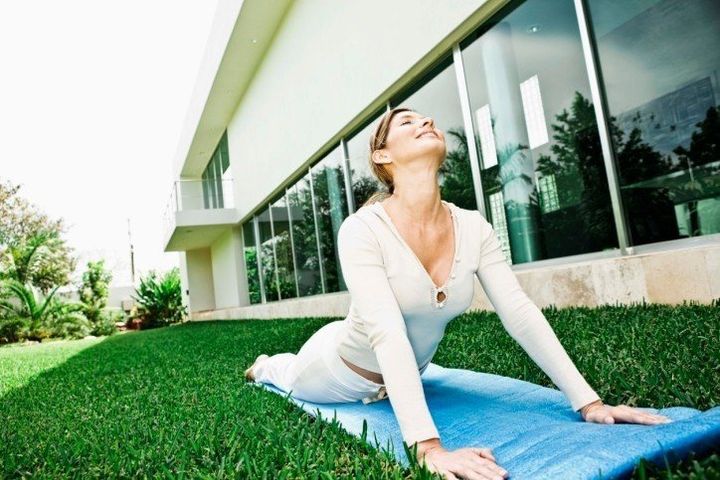
In yoga class, you'll often be told to "go deeper" while you're holding a pose. It's a yoga cliché, a lesson that's lost its power. It can be taken literally -- folding further, stretching more -- but that's not always the best idea. And often you're told to "go deeper" in a strength-building standing pose. So what exactly does it mean? We're not spelunking.
The first connection to the heart of the phrase is anatomical. Instead of looking at the silhouette of the pose, the shape or animal we're posing as, we can go deeper into the systems of the body. We feel for the structures underneath the skin.
Go one layer deeper and observe the muscles. Are the left quadriceps firing as strongly as the right? Are the shoulders tensing, even though they're not needed in the pose? It may seem obvious, but over time this attention reveals a surprising amount of information. I had a lot of weakness on my left side; when I rebalanced the muscles, my back pain went away.
Go another layer deeper, and observe the bones. Is the weight of the body resting into the heels, or the toes? Are the knees leaning to one side or another? Is the pelvis tipping forward, or backward? When the bones rest evenly on each other, a lot of the related muscles can relax. When the joints find a comfortable relationship, there is less wear and tear and strain.
(You can also do intense work with the connective tissue layers, which run around and throughout the muscles and bones, but that's a whole masters program by itself.)
The greatest benefit of a deep-diving approach to yoga is that you start working from your physical feelings, instead of your thoughts. You move according to your unique skeleton, instead of your compiled pictures of the pose. It turns the yoga poses inside out.
To get even more information, we can "go deeper" into some philosophy. Vedanta, one of the main classical philosophies of India, says that there are five koshas, or sheaths, to the body. (This was the first known example of an inner hierarchy.) The physical body, with all its complexities, is only the first sheath. It is "the food body," made of the things we eat and drink. We want to train and nurture it properly, but we'll miss the more subtle experiences if we identify too strongly with the container.
The second layer is the "vital energy," or prana. We access this layer most easily through the breath. Once we find our alignment in the yoga poses, we can restart our studies and see how we're breathing in each one. Which poses restrict the breath, or push it into new places? When does the breath stop, or quicken? Following the breath, instead of a teacher's narration, is a completely different class. The rhythm changes every day. For deep study and training of the breath, meditative poses are used.
Deeper than that is the mind, the third sheath. After we've trained the body and the breath, we can observe the mind more clearly. Thoughts, desires and emotions float in and out of our awareness. We acknowledge some sensations; we ignore others. We travel to the past, or the future. Mindfulness meditation, and other psychological tactics, help us detach from the flood of sensations, and observe their patterns or causes. Breathing exercises, visual focal points, sound vibrations, and other tools help us quiet the waves. Again, we can practice this study during yoga class, during our day-to-day activities, or in a quiet seated position.
When those three layers are clear (remember, don't hold your breath...), we have more access to the fourth layer: the intuition. This personal wisdom peeks out with small signals, and eventually starts to transmit deeper and deeper understanding. It's not thinking, it's knowing. It is your ego, in a positive sense: your knowledge of who you are, underneath all the conditioning. Moving from this layer is confident and unruffled. You're acting, not reacting.
And the deepest layer of us all is pure bliss. Remember an amazing view, an infatuated love, or an endorphin high. A pure high solo in a children's choir. A deep, satisfying sleep. That's sort of the nature of the innermost body. It's light, and peace, without any cause or conclusion. And those feelings aren't inserted into us; they're already inside. The practice of yoga just increases our transparency.
This philosophy gives us another map for the world inside our skin. We can go deeper into the layers of experience. We can train our minds to move from the outer shapes of our interactions with the world to the muscles and bones of anatomy, from the ebbs and flows of our energy to the icons of the mind, from the knowledge and wisdom of our intuition to the deep still peace at the center of it all. And we can call that yoga.